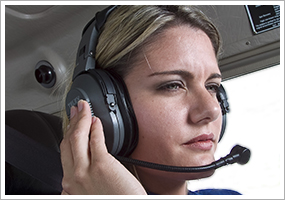training tips  Fighting frequency congestion Fighting frequency congestion Arriving or departing a busy airport can tax any pilot’s skills. And when a hole finally opens up in the traffic flow, it may still be impossible to get a word in edgewise on the radio to announce your intentions or get an airport advisory (see the Sept. 16, 2005, " Training
Tip: Airport Advisory"). Frequency congestion is a real headache—and it’s a constant reminder that a careful visual lookout is critical when operating under visual flight rules. Often the cause of frequency congestion is that numerous airports in the same area share a frequency, especially the unicom and common traffic advisory frequency (CTAF) 122.8 MHz. Many student pilots notice this and ask why 122.8 MHz tends to be “hotter” than other CTAFs. “Originally, 122.8 MHz was the standard unicom frequency for all airports. As flying activity and the number of airports increased, 122.7 MHz and 123.0 MHz were added to accommodate the increased traffic. Although three Unicom frequencies were unable to handle the general aviation Unicom traffic, additional frequencies were unavailable,” explains AOPA Online’s Air Traffic Services and Technology page. Complicating matters is that an airport sharing your frequency may have a runway with the same magnetic bearing as yours. Listen closely to announcements from pilots on the frequency for the airport in use. Sometimes you’ll hear an air traffic controller or a fellow pilot inform an aircraft over the radio that a transmission was stepped on or “blocked.” So common is the problem that you can even find the term in the Pilot/Controller Glossary: “BLOCKED—Phraseology used to indicate that a radio transmission has been distorted or interrupted due to multiple simultaneous radio transmissions.” The AOPA Online brief cited above notes that the situation is improving with changes that doubled the number of channels available to aviation. “AOPA successfully lobbied for additional frequencies when this change took place. Four more unicom frequencies became available: 122.725 MHz, 122.975 MHz, 123.050 MHz, and 123.075 MHz.” An example is Pinal Airpark in Marana, Ariz., using 123.05 MHz for CTAF and unicom. Check AOPA Airports and your charts for current airport frequency information. Then review the Air Safety Institute’s Safety Hotspot: Operations at Nontowered Airports for a complete safety check before your next flight. training products RAM iPad suction cup mount Are you using an iPad in the cockpit? Sporty’s offers the RAM iPad suction cup mount to keep it in place. The mount comes with a lifetime warranty and sells for $71.95. See the website or call 800-SPORTYS. Note: Products listed have not been evaluated by ePilot editors unless otherwise noted. AOPA assumes no responsibility for products or services listed or for claims or actions by manufacturers or vendors. final exam Question: Can I log cross-country time if the airport I am flying to is only 23 miles from my home airport? Answer: The short answer to that question is yes, with exceptions. FAR 61.1(b)(3)(i) defines cross-country time in broad terms. If the flight was accomplished in an aircraft by an individual with a pilot certificate and the flight included a landing at some place other than the departure airport and there was navigation involved, then it meets the definition. But, if a pilot wants to log cross-country time to meet the aeronautical experience requirements for a rating or certificate, a 23-mile flight would not count, as the point of landing in that case must be more than 50 nautical miles from the original point of departure. For an airline transport pilot certificate, no landing is required. Read more in AOPA’s subject report, Logbooks and Logging Time. Got a question for our technical services staff? E-mail [email protected] or call the Pilot Information Center, 800/872-2672. Don’t forget the online archive of “Final Exam” questions and answers, searchable by keyword or topic. |  Fighting frequency congestion
Fighting frequency congestion